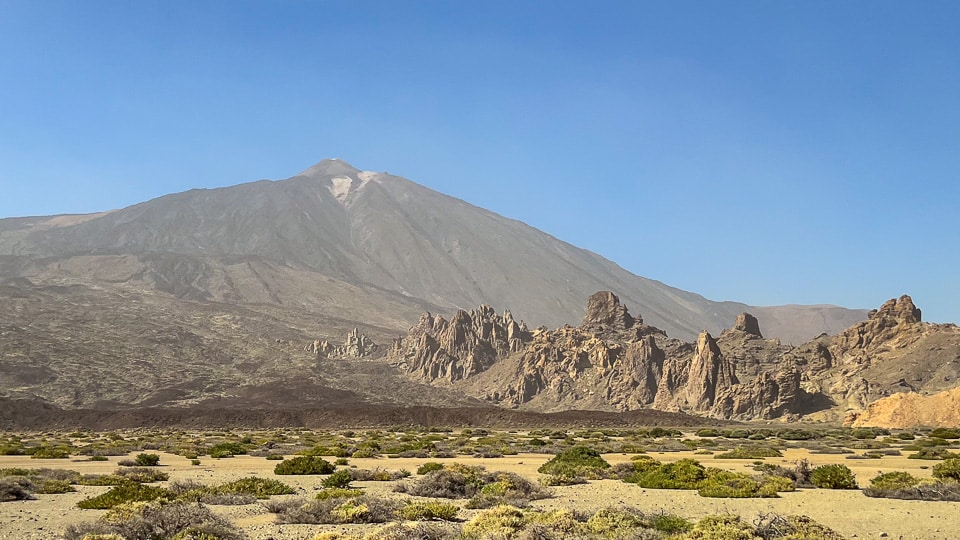
You could say all my travel is family travel since Tom and I are rarely far from each other. But family travel (with extended family) and intergenerational travel (with adult children and grandchildren) is not a common occurrence for us. Twice I’ve had the pleasure of visiting Spain’s Canary Islands – Tenerife to be exact – with family, and twice I’ve enjoyed the visit completely, though for very different reasons. For all ages, we now have a handle on the best places to visit and the best things to do in Tenerife.
The first family trip to the Canaries took me, without Tom, to Tenerife’s Northwest corner. This family trip included my sister-in-law Bonnie (it was all her idea, lucky me), my nephews Lars and Lucas, plus their lively partners Jenny and Ashlee. Interests ranged from hiking and biking to sunning, swimming and snorkeling; from photography to eating; and from browsing markets to people-watching on the beach. All our interests were well satisfied.
Our recent visit with two younger generations focused on kid-friendly activities. While the five- and seven-year-olds enjoyed Siam Park’s water features, the beach, and our condo’s pool and games, we all loved the seaside views, the al fresco dining, great seafood, and beautiful hiking in Teide’s National Park.
The Canaries are in the Atlantic Ocean, off the coast of Morocco and the Western Sahara, a.k.a. South Morocco. That places Tenerife around the 28th parallel, and about a three hour flight from Madrid. Though new to me, Tenerife has a long history and many old villages and landmarks. At the same time, its major cities are modern, and its infrastructure–including airports and expressways thoroughly up to date.
The triangular-shaped Tenerife Island, the largest island of the group, is distinguished by the towering Teide volcano, the highest peak in all of Spain. The northern coast is lined with steep cliffs and ravines falling into the Atlantic and exposed to the winds and clouds from the dominant northeast weather systems. The southern coast sports more gentle slopes, beaches, and sunshine.
From any location in Tenerife, it’s not difficult to make a day trip to any other locale on the island. And it’s easy to satisfy a wide range of interests.
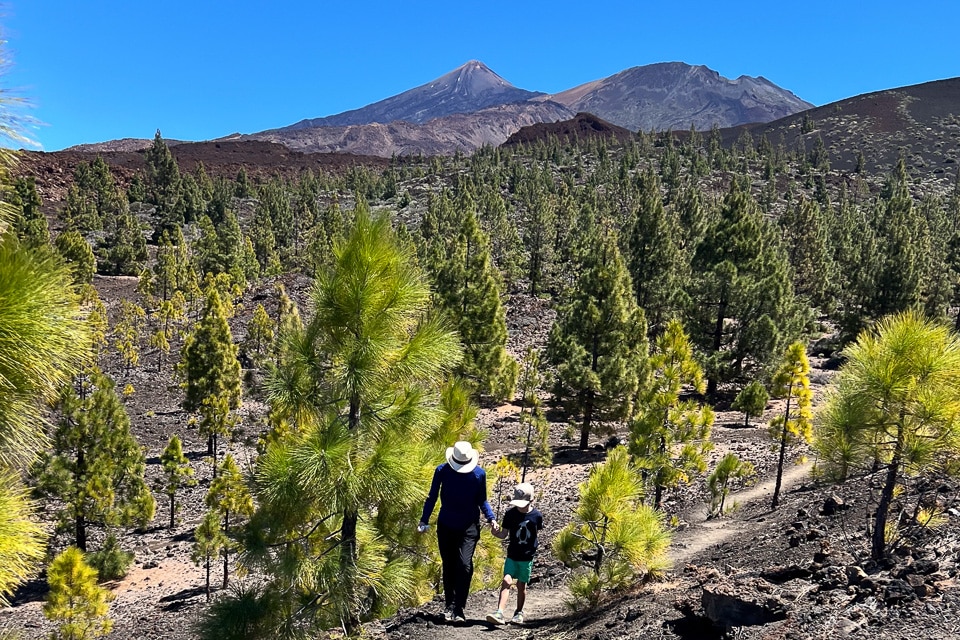
Table of Contents
Hiking and Biking
Tenerife is known for its great outdoor recreation, and we experienced all that we could. My crazy cyclist nephew (he does 500-mile races through Scotland) loved the biking down Teide and through the back trails crisscrossing the island. Hiking is available for young and old. Use AllTrails to find the right trails for your time and activity level.
For example, one of our favorite day trips with adults was to Masca, on the western side of Tenerife. We arrived via the spectacular, curvy mountain drive with views that thrilled everyone except the concentrating driver. (Thanks, Luke.) At Masca (more a widening in the road than a village) we stopped for a fine lunch at La Piedra, and then the younger set started their hike down the ravine – the barranco de Masca – about a two-and-a-half-hour trek descending through rocky terrain and wildly varying botanics.
We found a fascinating hike for all ages on the edge of Teide National Park. Called Samara Trail (AllTrails Sendero #13) we did almost three miles on a look trail that took us from fine clouds wafting over bright pines on black chinks of volcanic rock to clear skies and sharp views of Teide and Pico Viejo. This was a great choice, a trail from which we could see the various effects of lava flows, ash and boulders strewn from the volcano in areas that were sometime barren and sometimes transitioning into brush or pine forests.
Various trailheads offer a big range of views, looking up to Pico Teide or down to the coasts.
Our accommodations on the north coast of the island opened onto the lovely Ronda del Caballo, a mostly paved walkway along the coast at the tip of the cliffs. Situated between Puerto de la Cruz and San Juan de la Rambla, we were well situated to enjoy the hiking trail with views and catch some great meals in the village of Las Aguas. We recommend both La Escuela (for the popular Canary cazuela de pescado (fish stew) and Mesón Casa Mi Madre for exceptionally fresh, home-cooked food and a warm welcome.
Villages and Towns
For more immersion into Spanish culture, step away from the beaches and into the older towns of Tenerife. We started with a visit to the largest, the capital and port city of Santa Cruz de Tenerife, where we visited the historic Our Lady of Africa market. We stocked up on bread and cheese and jamón serrano, and then headed to Playa Teresitas on the northern edge of town, popular with locals, for an afternoon of swimming and lounging on the beach. (This is one of the red sand beaches imported from the Sahara. Many other beaches are black lava sand.)
The old town of San Cristóbal de la Laguna was founded in the 15th Century and named a UNESCO World Heritage Site in 1999. As Spain’s first non-fortified colonial town, it’s later ‘lower town’ organized around a central plaza, became a prototype for the grid format villages in the Americas. Check out the churches and the typical residential architecture featuring interior courtyards and wooden balconies.
On our earlier visit to Tenerife, we ladies enjoyed some restful hours over coffee and strolls through botanical gardens in the cute town of La Orotava. While we chilled in town, our adventurous young adults spent afternoons biking down the sides of Teide, or playing around at the beaches.
While many visitors swarm the cliffs at Los Gigantes, another option is the small town of Garachico. Since the town was wiped out by the volcanic eruption of 1706, it attracts attention now for its well-preserved 16th and 17th Century architecture, as well as for its parks and natural swimming pools. It’s a worthwhile visit after hiking around the nearby Chinyero Volcano.
On the northern edge of Tenerife, the town of Icod de los Vinos (population 25,000) with its surrounding areas showcases the various habitats of Tenerife all in one fertile area. Pine forests rise up the hills above, banana plantations, orchards and vineyards trace the lower regions, and the whole falls into the Atlantic at the famous Playa de San Marco. Icod de los Vinos is best known for the old “Dragon Tree” in town. It's some 22 meters tall with a trunk measuring 10 meters across, and said to be a thousand years old, though no one seems to be able to substantiate that.
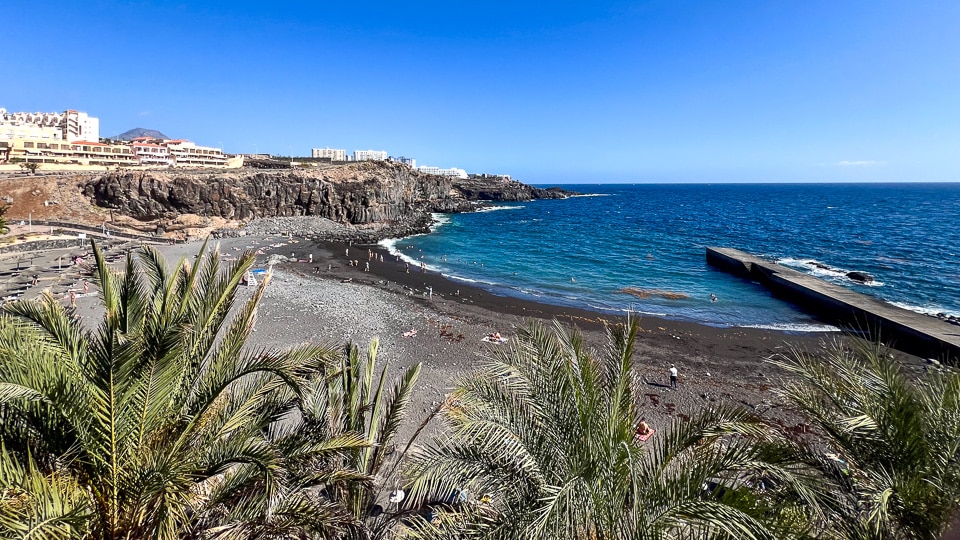
Beaches
The more temperate weather draws beach-goers to the south end of the island. Most popular are sandy coves around the Costa Adeje. We stayed in this vicinity in the beach town of Callao Salvaje and enjoyed a day at the mellow Playa de Ajabo.
You’ll find all the advantages of beach life around the area: beach toys for the kids, shade umbrellas, lifeguards, walk-up beach restaurants and bars, and yup the Hard Rock Café Tenerife. Drives and some hotels in the area offer views of La Gomera, the little Canary Island just off to the West.
Some of the most popular beaches are Playa del Duque (Adeje) and Playa de los Cristianos (both with the imported light Sahara sand), and Playa de las Americas. For a more secluded, black sand experience, find Bollullo Beach near La Orotava.
The beautiful beaches of Playa de San Marco were named for the visions of Saint Mark recorded there. Over the centuries, this natural cove has been a refuge for ships, a perfect spot for ship building, and, today, a wonderful black sand beach near the historic Icod de los Vinos.
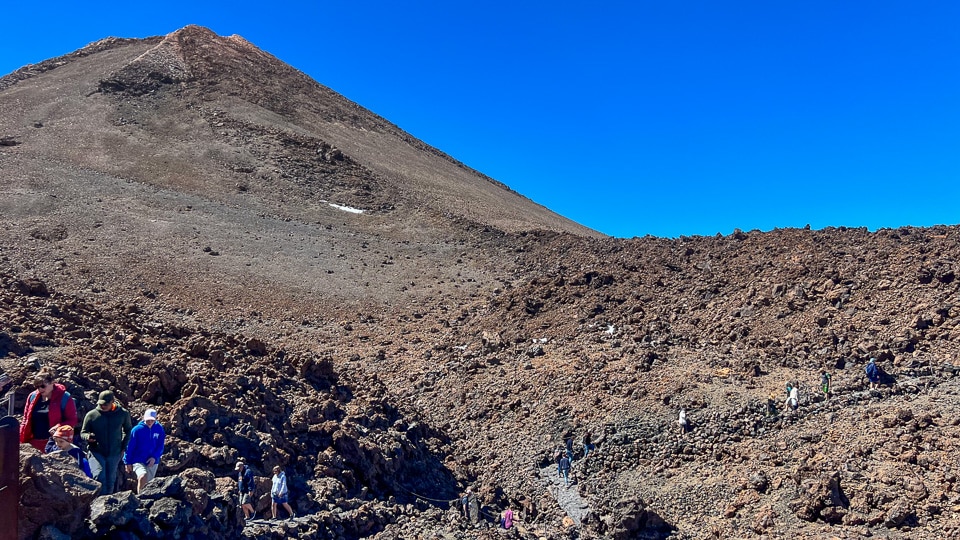
Teide National Park
In this huge national park, established in 1954, trails of all difficulty levels abound. (See hikes above.) The centerpiece of the park, of course, is the Teide volcanic peak. Teide is an active volcano, the highest point in Spain, a UNESCO World Heritage Site (2007), and the most visited national park in Spain – and eighth most visited in the world.
From sea level the elevation is over 10,000 feet (3,718 meters), or twice that from the base of the ocean, making it the third highest volcano in the world.
For those who want a view from the peak instead of at the peak, the Teide cable car carries about 40 passengers every 10 minutes up to the base of the Mount Teide peak. From here, with special permits, a few hardy souls are allowed to trek to the peak. Others choose to hike one way, down or up. For the rest of us, some short trails work their way around the base for views of the gas-spewing peak, the rough lava landscape, the slivers of snow remaining in the crevasses, and broad views across the wider caldera to the coast. Even on hazy or cloudy days, the experience is memorable.
Be sure to book tickets well in advance online. Be prepared for colder temps and winds atop. And if you are prone to vertigo, the cable car ride and quick elevation change may not be for you. Visitors are allowed an hour to roam around at the top.
While volcanic eruptions on Tenerife continue to be in the realm of possibilities (the most recent significant blow was in 1909), today’s visitors will simply enjoy the geology. Visit Spain’s tourism site for some excellent guidance to hiking among the historic volcanic landscapes.
For Younger Children (and all ages)
Siam Park
The highlight for kids (and therefore, by default, for happy parents) is Siam Park located in the Adeje area. Billed as the best water park in the world, this Thai-themed park is masterfully arranged to suit all ages and did not disappoint. Favorite water features included Lost City (splash playground), Wave Palace, the lazy Mai Tai River, and Jungle Snakes. The unexpected route through an aquarium of stingrays was a hit. A five or six hour stay, with a pause for lunch, seem to be about right.
Loro Parque
This aqua-centric zoo bills itself as an animal embassy. We didn’t visit do the drive north to visit, but it seems Loro Parque is making every effort to counter general criticism of aquatic mammals in captivity. The new Coral Kingdom looks promising and the Park is home to more than 400 species including birds, reptiles, mammals and fish.
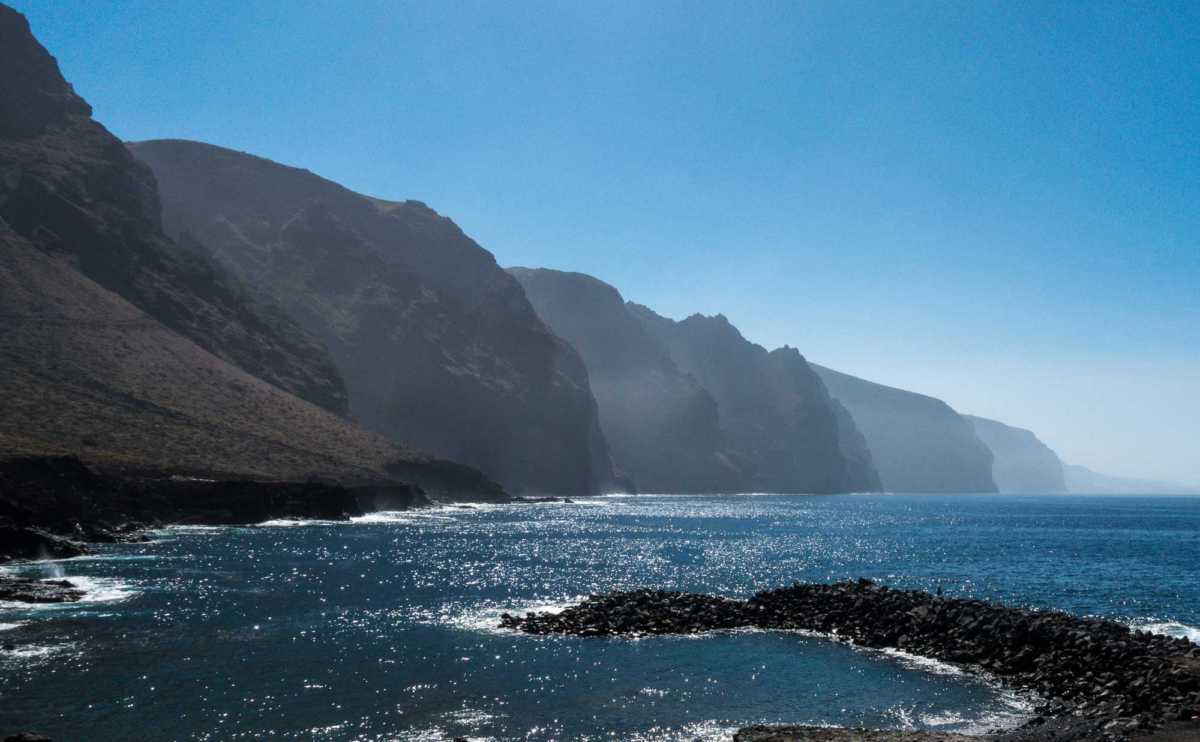
Scenic Views
The curvy roads are dotted with worthwhile miradors (view points) which are generally noted on Google maps with camera icons. Take your time and maximize your pleasure by pulling over regularly to enjoy the sights.
Note: driving times may be frustrating. Roads work their way around the scores of ravines running down the mountainsides, and recreation vehicles and gawking drivers, combined with few turn-outs, can make for a slow drive.
Acantilados de los Gigantes
One of the most popular miradors of Tenerife is Los Gigantes cliffs. We can recommend the views and photo opportunities from up top, but you might consider a boat ride to view see these dramatic rocks from the water below.
While our youthful adults set off on a hike, Bonnie and I drove to Los Gigantes port, from where we could catch a boat to meet the crew at the bottom of the Masca ravine. The boat trip runs along Los Gigantes cliffs, the huge folds of volcanic rock dropping down the southwestern edge of Tenerife. (Whale watching cruises are also popular from this harbor.) When we reached the cove at the bottom of the Masca ravine, we spotted the hikers rewarding themselves with a refreshing swim off the stony beach.
Arts and Culture
While the southern part of the island may appear to be a featureless resort region, it’s easy to find authentic culture on Tenerife. Particularly in Santa Cruz de Tenerife, but also in the interesting colonial towns of Tenerife, find arts and culture museums, performing arts, and (a highlight for us) Spanish residents. Check current calendars of events, or head to these perennial cultural centers.
Museum of History and Anthropology, Cristóbal de la Laguna
Museum of Ibero-American Crafts, La Orotava
Archeological Museum, Puerto de la Cruz. Art and culture of native Guanche people.
Teatro Guimerá, Santa Cruz de Tenerife
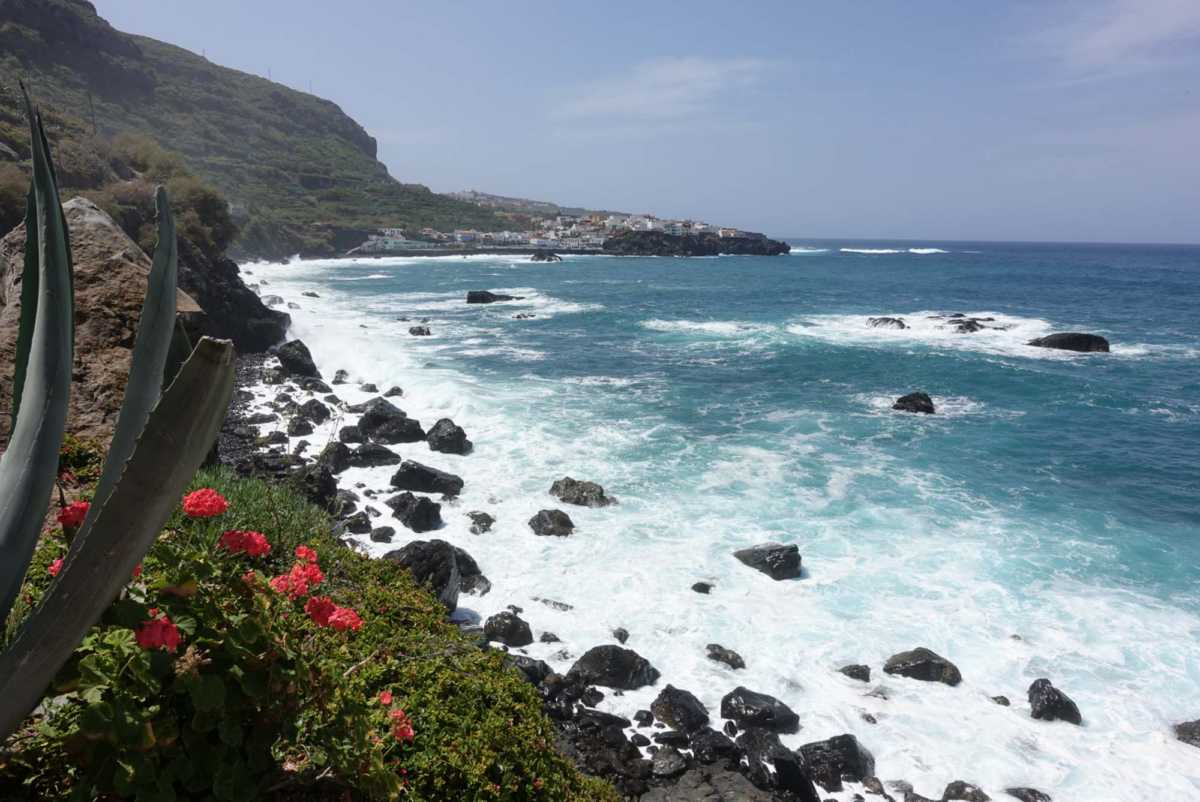
Family-Friendly Accommodations
We've found our accommodations for our two visits according to extended family needs. So in both cases we booked multiple bedrooms, common living and kitchen space. We recommend using search filters for your preferences, such as with swimming pool, near beach, or proximity to restaurants. You'll find traditional hotels as well as rental properties via Booking.com, which is generally where we start all our lodging searches.
Notable Restaurants
In the village of Las Aguas, we recommend both La Escuela (for the popular Canary cazuela de pescado (fish stew) and Mesón Casa Mi Madre for exceptionally fresh, home-cooked food and a warm welcome.
In Callao Salvaje, we felt no need to pile into the car in search of distant eateries when we could walk a couple blocks to the town center and have our choice of fare. We can recommend La Parma for brunch or a good pizza in a relaxed shady setting. On the beach we returned to L’Osteria Sea a couple times for drinks, lunch and dinner – in various groupings depending on who was babysitting.
Two fine dinners were at La Divina Comida where the lamb chops outshone all other dishes, and at Delfin. Get to Delfin early for seating and the delicious catch of the day (Red Snapper in our case) in this lively spot attached to the rocks above the Ajabo beach.
When to Travel to Tenerife
The best time to visit Tenerife depends on who you ask. Sunshine is the norm throughout the year; April through November are desirable. The summer months of June through September are ideal for those who like the heat. Typical summer temperature highs are near 30 Celsius, or in the high 70s and low 80s Fahrenheit.
Winter months, especially over the holidays are also popular. As usual, best deal can be found during the should seasons
When planning your Tenerife travel dates, keep in mind the opportunities for clear night sky viewing.
Resources
For more ideas about isiting Tenerife, other islands of the Canaries, Spain's National Parks, or other regions of Spain, visit the informative official Spain tourism website.
Advertiser Disclaimer and Editorial Note: Some links on this page may have been placed by companies from which TravelPast50.com receives compensation. This compensation may impact how and where products are mentioned within a post.
Up Your Travel Skills
Looking to book your next trip? Use these resources that are tried and tested by us. First, to get our best travel tips, sign up for our email newsletter. Then, be sure to start your reading with our Resources Page where we highlight all the great travel companies and products that we trust. Travel Accessories: Check out our list of all the accessories we carry to make getting there and being there a lot easier. Credit Cards: See our detailed post on how to choose the right travel rewards credit card for you. Flights: Start finding the very best flight deals by subscribing to Thrifty Traveler. Book your Hotel: Find the best prices on hotels with Booking.com. See all of the gear and books we like in one place on our Amazon shop.Got a comment on this post? Join the conversation on Facebook, Instagram, or Threads and share your thoughts!



Comments are closed.